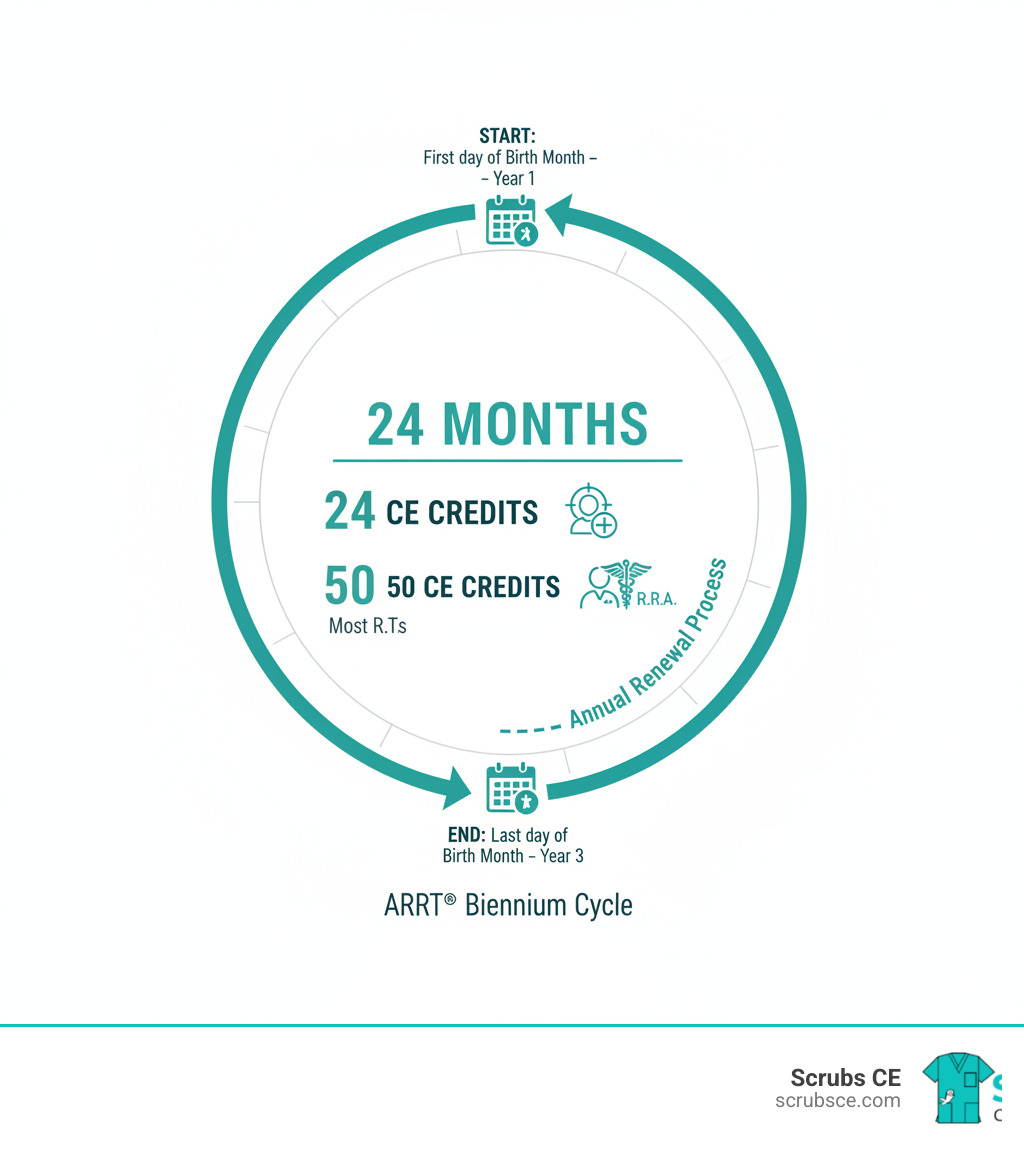Why Radiologic Technologist CE Matters for Your Career
Radiologic technologist CE (continuing education) is required to maintain your ARRT certification and registration. Most radiologic technologists need 24 approved CE credits every two years (a biennium), while Registered Radiologist Assistants need 50 credits per biennium.
Quick Answer: How to Find Radiologic Technologist CE
- Online CE Providers – Self-paced courses with instant certificates.
- Professional Organizations – Membership often includes CE credits and access to course libraries.
- Unlimited Subscription Services – A flat annual fee for access to a large library of credits.
- Academic Courses – University courses that convert to a high number of credits.
- Conferences & Seminars – In-person events for networking and hands-on learning.
Your biennium starts on the first day of your birth month and you must report your CE credits by the last day of your birth month at the end of the two-year cycle.
Juggling patient care, new technology, and CE deadlines is a familiar challenge. The good news is that finding quality CE has never been easier. Gone are the days of mandatory travel for conferences; today’s technologists have flexible online courses, professional resources, and subscription services that fit any schedule.
With so many options, it’s important to find the right CE for your needs. Whether you’re maintaining certification, pursuing advanced credentials, or meeting state requirements, understanding your options is key. CE isn’t just about checking a box—it’s about maintaining competence, demonstrating accountability, and ensuring the best care for your patients.
Let’s explore the five most effective ways to earn your radiologic technologist CE credits without breaking your budget or schedule.
First, Understand Your Core CE Requirements
Before searching for courses, it’s crucial to understand your specific requirements from the American Registry of Radiologic Technologists (ARRT). Knowing these rules prevents last-minute panic as your deadline approaches.
The foundation is straightforward: Most radiologic technologists need 24 approved CE credits every two years. This two-year period is called a “biennium.” For Registered Radiologist Assistants (R.R.A.s), the requirement is 50 credits per biennium.
Your biennium cycle is tied to your birth month. It begins on the first day of your birth month, runs for two years, and ends on the last day of that same month two years later. You report your completed CE during your annual renewal, which opens about two months before your birth month.
Crucially, the ARRT does not track your past CE activities. You are responsible for maintaining all CE documentation for at least four years. These certificates are your proof of compliance if any questions arise.
The ARRT offers a guide to maintaining your ARRT credential that details these requirements. For more on why this matters, see the importance of continuing education for X-ray technologists. You can also request to change your biennium year if the cycle doesn’t fit your schedule, offering helpful flexibility.
What Types of CE Activities Are Accepted?
Not all educational activities count toward your radiologic technologist CE requirements. The ARRT specifies what qualifies, so understanding these categories saves you time and money.
- Category A or A+ Activities: These are the gold standard, approved by a Recognized Continuing Education Evaluation Mechanism (RCEEM). Most state boards also require Category A credits.
- Academic Courses: Courses from an accredited college or university are a great option. You earn 16 CE credits per semester credit or 12 CE credits per quarter credit for relevant coursework.
- Advanced CPR: Certifications like ACLS, PALS, or ATLS can earn you up to six credits per biennium. Basic BLS does not count.
- Authoring Articles: Writing a peer-reviewed article for an approved journal can earn you CE credit.
- Applications Training: Training on new equipment from a manufacturer may count if it meets ARRT clinical application criteria.
Activities that don’t count include basic CPR, clinical instruction (with some exceptions), and earning a new credential itself (though the required education often does). For full details, consult the ARRT’s Education Requirements for Obtaining and Maintaining Certification and Registration.
The Evolution of CE: Online vs. In-Person
The way technologists earn radiologic technologist CE has changed dramatically. The choice between online and in-person learning offers different advantages.
Online learning offers best flexibility. You can complete self-paced courses anytime, anywhere, fitting education around your work and life schedule. The variety of topics is vast, and costs are typically much lower than in-person events.
However, in-person conferences and seminars provide unique benefits. They are excellent for networking with colleagues, meeting mentors, and finding job opportunities. Hands-on workshops allow you to practice new techniques on modern equipment, and live Q&A sessions provide direct access to experts.
Many technologists find a blend of both approaches works best. Use affordable online courses for core requirements and attend an occasional in-person event for networking and specialized, hands-on training. To see what’s next in CE, check out these 5 Trends Transforming Radiology Continuing Education You Need to Know.
The 5 Best Ways to Earn Your Radiologic Technologist CE Credits
Now that you understand the requirements for radiologic technologist CE, let’s explore how to earn your credits. We have more convenient and affordable options than ever, so there’s no need to dread your biennium deadline.
Whether you prefer learning from home or networking at a conference, there’s a path that fits your lifestyle, budget, and professional goals. You can even mix and match these approaches to create a personalized CE strategy.
Let’s explore the five most effective ways to earn your credits without the stress.
1. Online CE Providers & Course Marketplaces
Online CE providers have transformed how radiologic technologists meet their radiologic technologist CE requirements. The primary benefit is flexibility—you can complete courses on your schedule, whether on a lunch break or late at night.
Here at Scrubs CE, we’ve been helping healthcare professionals since 2001. We design courses specifically for your profession that speak your language and address your daily challenges. When you finish a course, you get your certificate instantly, with no waiting.
The variety of online topics is another advantage, from radiation safety to advanced modalities. For even greater value, our radiology CE course combos bundle related courses at a better price point.
We know your time is valuable, so our enrollment process is fast and simple. You can enroll in X-ray CE in minutes and start learning immediately. Our courses are ARRT-approved and accepted by most state boards, offering an affordable and convenient way to stay compliant and in control of your professional development.
2. Membership in Professional Organizations
Joining a professional organization is a smart investment in your career. Beyond networking and advocacy, many organizations bundle substantial radiologic technologist CE benefits directly into the membership fee, offering a great return on investment.
Upon joining, members often receive a block of CE credits that can satisfy a large portion of their biennial requirement. This immediate benefit makes membership an efficient way to get a head start on your CE.
In addition, membership frequently includes access to an extensive online CE library. These libraries contain a wide selection of courses covering various modalities, from radiography and CT to mammography and radiation therapy. This allows you to explore different topics and stay current without extra cost.
Learning formats are also diverse. Many organizations offer credits for reading and reviewing professional journal articles or watching recorded webcasts from industry experts. These activities typically count as Category A credits, accepted by the ARRT and most state boards.
Beyond CE, membership provides access to job boards, salary surveys, and advocacy efforts that support the profession. It’s an investment that contributes to both your immediate CE needs and long-term career growth.
3. Unlimited Access Subscription Services
Imagine a streaming service model for your radiologic technologist CE credits. That’s what unlimited access subscription services offer, and they can be a game-changer.
These platforms operate on a simple premise: pay one flat annual fee for access to their entire library. No per-course fees or worrying about the cost of an extra credit. Many services offer access to hundreds of CE credits for a low yearly price, typically approved by the ASRT for ARRT certification.
This model is ideal if you have high-volume credit needs, such as R.R.A.s who need 50 credits or technologists with multiple certifications. It’s also perfect for those who simply love to learn and want to go beyond the minimum requirements.
Another key benefit is the ability to explore new modalities without financial risk. If you’re curious about CT or MRI, you can take introductory courses to test the waters while still meeting your current CE requirements. These platforms keep their content fresh, ensuring you’re learning about the latest advancements.
The budget-friendly nature of these subscriptions is a major advantage over buying individual courses. For more insight on getting the most value, see why a combo e-course is a good fit for your radiology CE. The peace of mind from having unlimited learning potential at your fingertips is invaluable.
4. Academic Courses and Advanced Certifications
For those looking to advance their careers, academic courses and advanced certifications provide a powerful way to earn radiologic technologist CE while opening new professional doors.
Many technologists don’t realize that university or college courses can be worth significant CE credits. Each academic semester credit converts to 16 CE credits, and each quarter credit converts to 12 CE credits, as long as the coursework relates to radiologic science. A single three-credit course could fulfill half of your biennium requirement.
This approach is ideal for those who thrive in a structured learning environment and want to make serious progress on their CE.
Furthermore, if you plan to earn a new post-primary credential in a modality like CT, MRI, or Mammography, the required structured education often counts toward your biennial CE. Structured education is the ARRT’s comprehensive training pathway for entering a new specialty. By pursuing a new credential, you are essentially earning your CE while building a new skill set and advancing your career.
This pathway to explore other modalities can transform your career trajectory. Every hour spent serves double duty—fulfilling CE obligations and making you a more valuable and marketable professional. To learn more, read about what you need to know about ARRT’s structured education solutions and requirements.
5. In-Person Conferences, Seminars, and Lectures
While online courses offer incredible convenience for earning radiologic technologist CE, in-person events still hold a unique value in professional development.
Attending a live event, like a state society conference or a specialized seminar, offers more than just credits. The networking opportunities can be career-changing, connecting you with colleagues, mentors, and potential employers. These professional relationships often last long after the event ends.
From an educational standpoint, in-person events feature hands-on workshops where you can practice new techniques on actual equipment. Live Q&A sessions allow you to get immediate, specific answers from experts. For some, the structure of a conference is a great way to focus and earn many credits in just a few days.
The trade-off is the cost of registration, travel, and time away from work. However, many technologists find a hybrid approach—combining affordable online courses with an occasional in-person event—provides the best of both worlds. These events remind us we are part of a larger professional community dedicated to patient care. For more on this, see the 5 benefits of continuing radiology education.
Navigating Specific and State-Level CE Requirements
Meeting your ARRT requirements is the baseline, but you may have additional radiologic technologist CE rules to follow. Your state licensing board and specific modality can have their own requirements that go beyond the ARRT’s.
These rules exist because different states have unique regulations and imaging specialties have specific competency concerns. It’s crucial to be compliant with both ARRT and state-level requirements to avoid issues with your license renewal.
Modality-Specific Radiologic Technologist CE
Specialized modalities often require focused continuing education to ensure expertise and patient safety.
- Mammography: Under the Mammography Quality Standards Act (MQSA), technologists need 10 of their 24 biennial credits to be specific to mammography. You can find more on mammography continuing education requirements.
- Fluoroscopy: If you hold a fluoroscopy permit, four of your 24 CE credits must focus on radiation safety for fluoroscopy. This is particularly relevant in states like California. Learn why you should take your fluoroscopy radiation safety CE’s for California.
- Sonography: Sonographers must earn 16 of their biennial CE credits directly related to their discipline.
- CT and MRI: While not always mandated by ARRT, many states and employers require modality-specific CE to stay current with these advanced technologies. Understanding what is involved in MRI training can guide your CE choices.
State-Specific and Other Radiologic Technologist CE Rules
Many state licensing boards have their own radiologic technologist CE requirements in addition to ARRT’s.
California, for example, requires 24 Category A or A+ credits every two years, with four of those credits focused on digital radiography—a requirement unique to the state. You can find a guide on how to maintain your X-ray license in California and official details from the California Department of Public Health – Radiologic Health Branch (RHB).
Other states like Florida and Texas have their own acceptance criteria and approval processes. Limited Permit X-Ray Technicians (XTs) also have specific CE requirements, including 24 approved credits every two years, with four in digital radiography if they have that authorization.
The bottom line is to always check your state’s specific guidelines. We offer courses accepted in many states, including California, Florida, and Texas, to help you meet these varied requirements.
Frequently Asked Questions about Radiologic Technologist CE
Navigating radiologic technologist CE can bring up questions. Here are clear answers to the most common ones.
How many CE credits do I need and how often?
Most radiologic technologists must complete 24 approved CE credits every two years (your biennium). This cycle is tied to your birth month, starting on the first day and ending on the last day two years later. Registered Radiologist Assistants (R.R.A.s) have a higher requirement of 50 approved CE credits each biennium. Always check your personal ARRT account to confirm your specific requirements and deadlines.
What is the difference between Category A credits and Structured Education?
This is a common point of confusion. Category A credits are for maintaining your current certification. These are the 24 biennial credits most technologists need, covering topics relevant to daily practice. Structured Education, on the other hand, is required when you want to earn a new credential in a different modality, like CT or MRI. It’s a comprehensive, modality-specific curriculum you must complete before taking the certification exam. The good news is that credits earned through structured education often count toward your biennial CE requirement. Learn more about ARRT’s structured education solutions and requirements.
What happens if I don’t complete my CE on time?
Missing your CE deadline has serious consequences. The ARRT will likely place you on CE probation, requiring you to complete the overdue credits within a set timeframe and pay additional fees. Your certification remains active during probation, but it’s a formal warning. If you fail to resolve the probation, you risk losing your ARRT certification and registration entirely. Reinstatement is a complex and expensive process with no guarantee of success. Planning ahead and using flexible online options can help you avoid this stressful situation. The official consequences are detailed in the ARRT Rules and Regulations.
Conclusion
Hopefully, you now feel more confident about managing your radiologic technologist CE requirements. Continuing education is more than a mandate; it’s a commitment to lifelong learning, professional growth, and ultimately, better patient care. The medical imaging field evolves quickly, and CE keeps you sharp, adaptable, and marketable.
As we’ve explored, there are many ways radiology CE can benefit you as a radiologic technologist. The best part is that you have flexible and affordable options. Whether you prefer online courses, professional memberships, subscription services, academic study, or in-person conferences, there is a path that works for you.
Take control of your professional development. Don’t wait until your biennium deadline is near. Start exploring courses that interest you and make learning a rewarding part of your career.
Ready to begin? Explore our extensive library of Radiology CE Courses to make your next biennium a breeze!





Recent Comments